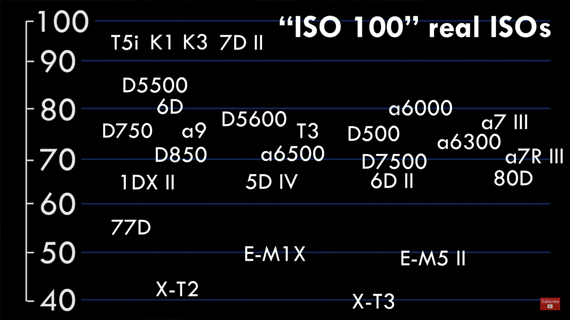When opening up your aperture and slowing down the shutter speed doesn’t cut it, we opt to increase the ISO value to make the images brighter. This is supposed to make the sensor more “sensitive” to light. ISO is something that came into existence from the film days. But does it hold the same significance in today’s world of digital photography? Photographer Tony Northrup believes that camera manufacturers are dishonest about ISO:
ISO Is Not Standardized
ISO, which stands for the International Organization for Standardization, actually lacks standardization. What an irony! Actually, ISO is an organization that has done amazing work in standardizing across various platforms. But that doesn’t seem to be the case in photography. Have a look at the following images taken with different cameras with the same settings and lighting conditions:

The top image is a full stop darker. Why do you think the ISO performances are different?
Manufacturers have been using the base ISO value as 100 from the early days. But with time, sensor technology has kept on improving, and the sensor’s ability to absorb light has been improving as well. However, the base ISO is still 100. So, in fact, a camera might be performing at ISO 1600 when you set the camera’s ISO to 3200. This makes you feel that the camera is capturing cleaner images at a particular ISO with its every new iteration.
Here’s a visualization of the real ISO values that manufacturers label as ISO 100:

ISO Is Not a Physical Change
Changing the aperture and shutter speed have physical implications. The aperture sizes and the duration for which the sensor is exposed change. But nothing physical happens when you change the ISO value. The camera just determines how it’s going to post-process that image based on the ISO setting.
“The ISO you choose in your camera is just a post-processing instruction exactly like dragging the exposure slider in Lightroom. It is just digital gain.”
Upper ISO is Completely Made Up
Since increasing the ISO is just a way to multiply the numbers in a picture, why should there be a limit to it? By putting a limit on ISO, manufacturers are putting a limit on how high the camera multiplies the values that the sensor gives out.
“The really upsetting thing is when manufacturers market a new camera and they brag about the new upper limit. It’s not really an indication that the sensor is actually more sensitive. They’re just letting you multiply by a bigger number.”
Lower ISO Could Be Eliminated
A feature like the digital ND filter that’s built into modern cameras can allow shutter speeds to go up to 32 times the normal speed. This has all been made possible by the development of electronic shutters. So using this feature, instead of 1/100 second, you can shoot at 1/3 second, which is great for long exposures. Similarly, shooting at ISO 100 could become equivalent to shooting at ISO 3 with a virtually noiseless image.
Is ISO performance something you consider when purchasing a new camera?
“That setting on your camera, ISO, is basically fake and based on almost nothing.”
Go to full article: Are Camera Brands Following ISO Standards?
What are your thoughts on this article? Join the discussion on Facebook
PictureCorrect subscribers can also learn more today with our #1 bestseller: The Photography Tutorial eBook
The post Are Camera Brands Following ISO Standards? appeared first on PictureCorrect.
from PictureCorrect https://ift.tt/2Xjs5Jj
via IFTTT






0 kommenttia:
Lähetä kommentti